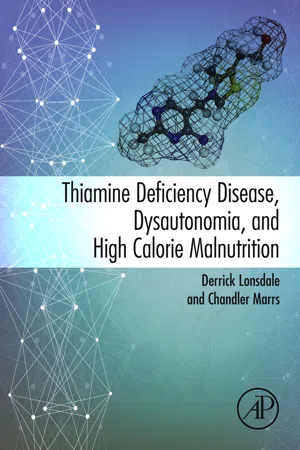
Thiamine Deficiency Disease, Dysautonomia, and High Calorie Malnutrition
- 356 pages
- English
- ePUB (mobile friendly)
- Available on iOS & Android
Thiamine Deficiency Disease, Dysautonomia, and High Calorie Malnutrition
About this book
Thiamine Deficiency Disease, Dysautonomia, and High Calorie Malnutrition explores thiamine and how its deficiency affects the functions of the brainstem and autonomic nervous system by way of metabolic changes at the level of the mitochondria. Thiamine deficiency derails mitochondrial oxidative metabolism and gives rise to the classic disease of beriberi that, in its early stages, can be considered the prototype for a set of disorders that we now recognize as dysautonomia. This book represents the life's work of the senior author, Dr. Derrick Lonsdale, and a recent collaboration with his co-author Dr. Chandler Marrs.- Presents clinical experience and animal research that have answered questions about thiamine chemistry- Demonstrates that the consumption of empty calories can result in clinical effects that lead to misdiagnosis- Addresses the biochemical changes induced by vitamin deficiency, particularly that of thiamine
Frequently asked questions
- Essential is ideal for learners and professionals who enjoy exploring a wide range of subjects. Access the Essential Library with 800,000+ trusted titles and best-sellers across business, personal growth, and the humanities. Includes unlimited reading time and Standard Read Aloud voice.
- Complete: Perfect for advanced learners and researchers needing full, unrestricted access. Unlock 1.4M+ books across hundreds of subjects, including academic and specialized titles. The Complete Plan also includes advanced features like Premium Read Aloud and Research Assistant.
Please note we cannot support devices running on iOS 13 and Android 7 or earlier. Learn more about using the app.
Information
The History of Thiamine and Beriberi
Abstract
Keywords
From Kakke to Beriberi
Thiamine With Malnutrition: Navy Sailors Connect the Dots
Polished Rice, Pigeons, and the Catatorulin Effect
Clinical Features of Beriberi: Early Accounts
Historical Observations of Beriberi Symptoms
Appearance
Table of contents
- Cover image
- Title page
- Table of Contents
- Copyright
- Dedication
- Introduction: Why Thiamine? Why Now?
- Chapter 1. The History of Thiamine and Beriberi
- Chapter 2. The Autonomic Nervous System and Its Functions
- Chapter 3. Mitochondria, Thiamine, and Autonomic Dysfunction
- Chapter 4. Evaluation and Treatment of Thiamine Metabolism in Clinical Practice
- Chapter 5. Thiamine-Deficient Dysautonomias: Case Insights and Clinical Clues
- Chapter 6. High-Calorie Malnutrition and Its Impact on Health
- Chapter 7. The Three Circles of Health
- Chapter 8. Energy Metabolism in a Revised Medical Model
- Index